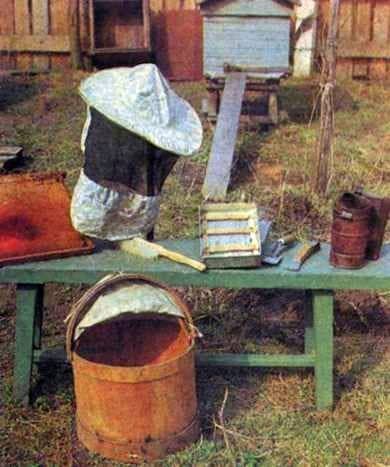
Any business requires proper organization of work, and beekeeping is especially important. Because there you have to work with living beings. Many of the works on the apiary are very labor-intensive – shrinking the streets, expanding the nests as families grow, etc. All these operations are performed at different times, the nests are often opened, which disrupts the thermal regime inside the hives. And this, in turn, can cause brood disease, reduce the egg-laying of the uterus, and further reduce the productivity of the family.
Many beekeepers-amateurs seek to increase by any means the number of families. At the same time, strong, middle and weak families inevitably appear. Each has to be serviced according to an individual plan, which is very troublesome and unprofitable.
Some unproductive spend time on the correction of bezmotochnyh or otrutnevshih families. But the beekeeper should strive to ensure that only strong families are in the apiary. This will allow them to carry out group care, that is, any operation (feeding, waxing and building frames, treatment, etc.) should be carried out simultaneously, which is especially convenient for beekeepers who do not have the opportunity to permanently stay in the apiary.
Align the strength of families by transferring the framework with brood from strong to less strong. But this method is only permissible if the bees are healthy. It can be used with varroatosis, if, of course, treatment is carried out simultaneously in all families. In order to organize planned work on the apiary, one should not focus on natural swarming. Imagine, spring is too late, families are developing slowly, and the weather in May and June is rainy. Swarming then begins with a great delay. To the main honey collector in July, families will not gain enough strength and they will not be able to give honey anymore.
Prevent swarming with the help of layers, which put the mature queen cells, barren or fetal queens.
It is better to plant a mature uterus in the brood, then there will be no delay in its development, because on the 2nd-3rd day the ancestor starts laying eggs.
Many beekeepers make pre-fabricated layers, selecting frames with brood and bees sitting on them from two or three strong families. These layers quickly gain strength and successfully participate in the main honey collector.
Fetal queens can be prescribed in beekeeping farms, but it is more convenient to take them out on their apiary.
This is done so. First they prepare a strong, productive family for the withdrawal of drones, without which it is impossible to get pregnant queens. In the spring it is strengthened by three or four frames with brood and bees. In the middle of the nest put two drone honeycombs, the nest is warmed, and the bees are fed sugar syrup (in proportion 1: 1).
From the nest of the maternal family intended for the withdrawal of queens, one honeycomb with one-day larvae is removed and cut in half horizontally. The larvae are left in the third cut-off line, and the others are removed. Such a honeycomb is placed in a family-educator, after removing from it all the frames on which there is an open brood, and the uterus. Bees, sensing that they are orphaned, immediately begin to withdraw new queens on a cut sausage (delayed queen cells). The nest of the family-educator is also warmed, if necessary, and the bees are fed. On the 10th day, queen cells are encased in the uterine cells and put back into the nest until the young uterus is released, which is then used to replace the old ones, and also to organize the layers.
To prevent swarming, many amateur beekeepers cut off all the queen cells. This operation, meaningless in its essence, is harmful to bees, as it breaks the rhythm of the family. The bees immediately lay new queen cells. In two weeks, the family will still come off.
One of the measures of rational organization of labor in the apiary is the maintenance of single-age queens in all families. This allows the beekeeper to conduct countermeasures and other works simultaneously.
Of great importance is the system of hives in which bees are kept. The choice of it – a matter of taste, but to beginner beekeepers, I would recommend a single-case twelve-frame with two store extensions. Such extensions, designed for storing commercial honey, allow to increase the honeycomb economy. From these honeycombs do not go bees, so they serve for a long time, in addition, the beekeeper does not have to bother with separate frames, but you can work with whole extensions. Shop half-frames are less likely to break when pumping honey, and bees spend less time for their restoration, respectively.
In the apiary, there must be a stock of frames with empty honeycombs, so that they will be enough for all families for the period of the main honey collection. Otherwise, the bees will have to rebuild them for several days, instead of immediately laying honey in ready-made cells. Losses can range from 5 to 10 kg of honey per day (the norm for a strong family). Stored frames in tight, specially adapted boxes or in cases (stores), where the wax moth should not penetrate.
Equipping an apiary with good equipment and the necessary equipment is also of great importance for increasing the productivity of the beekeeper. It is desirable that the inventory, tools – a chisel, a knife for printing out honeycombs, an obverse mesh, a uterine cell, a smoke, etc. – were available to the beekeeper not in one copy. Required in the apiary and lightweight portable plywood boxes, which are framed when inspecting families during the spring audit, at the time of expansion of nests or in the organization of layers.
And in conclusion, we can say – the more order in the apiary, the higher its productivity.
Сбор пчелами нектара и пыльцы. Как коптить сливу.
Young Beekeeper